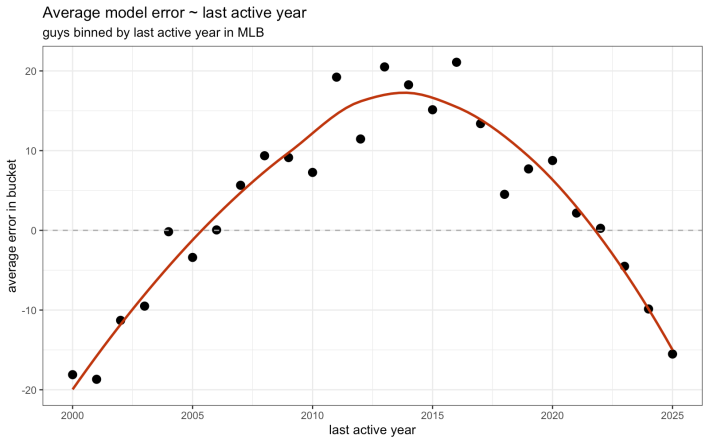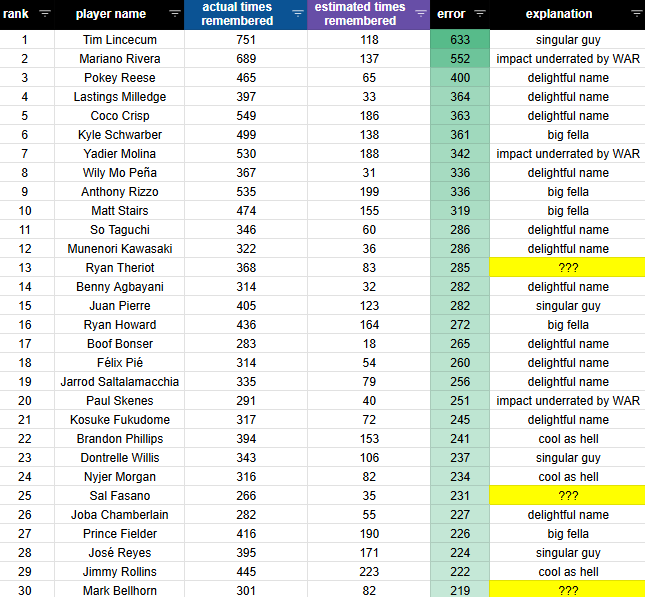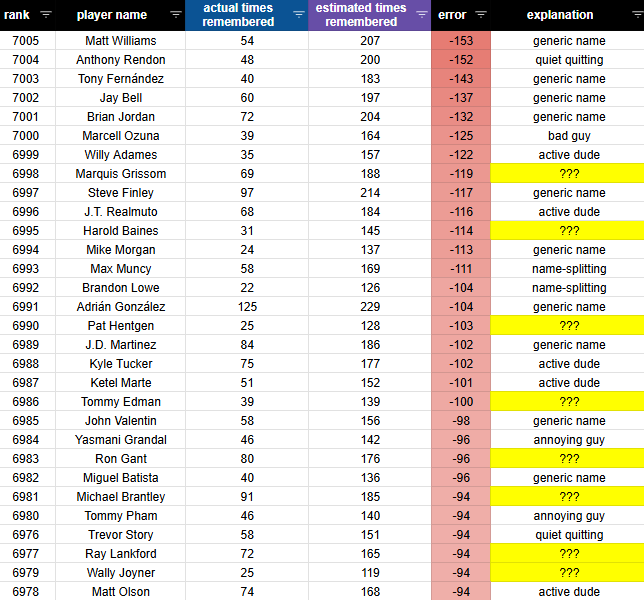Two weeks ago, in partnership with our pals over at Immaculate Grid by Sports Reference, we announced Some Guys I Remember From The 21st Century. Between then and now, we remembered not just some but a whole lot of Guys. Many of you did the same: As of last week, 24,455 distinct athletes had been remembered across more than 36,000 submitted grids. That is quite a bit of remembering, even if you strip out David Roth’s [number redacted] entries.
Across all sports, the most-frequently remembered players comprise a nonet of MLB legends:
- Ichiro Suzuki – 1,360
- Albert Pujols – 1,304
- Derek Jeter – 1,291
- Mike Trout – 1,172
- Ken Griffey Jr. – 1,160
- Aaron Judge – 1,090
- David Ortiz – 1,075
- Shohei Ohtani – 959
- Pedro Martinez – 943
The leading vote-getters outside of baseball were LeBron James (606), Tom Brady (577), and Lionel Messi (492). A world in which Ichiro is twice as salient as Tom Brady sounds pretty good to me. Sidney Crosby, Alex Morgan, and Caitlin Clark respectively received the most votes among hockey, women’s soccer, and WNBA players. You can peruse the full results here.
This exercise bore much fruit: I got to know Bill Pulsipher’s facial hair, became reacquainted with Ryan Garko and JB Shuck, and contemplated avant-garde Grid strategies. I received confirmation that at least 10 other people also still had Josh James in active memory. Crunching the numbers also taught me something about the types of Guy we remember. Brace for some math words after the section break.
It’s obvious from the leaderboard above that player quality is the main determinant of Getting Remembered. Focusing on MLB, the correlation coefficient between the number of times a Guy was remembered and their 7-year Peak WAR is a couple of points higher than the correlation between the number of times a Guy was remembered and their career WAR, 2000s WAR, JAWS, or playing time. This makes sense: Guys who burn bright impart their afterimage in our retinas.
If you remove from the 7,130 ballot-eligible MLB players the unambiguous Dude-level performers—the 125 players in this quarter-century with a 7-year Peak WAR of 35 or more—and then subset to players who haven’t played in 2025, the relationship between Quality and Getting Remembered becomes extremely clear. Each point in the plot below represents a 1-WAR bucket of Guys, and the y-axis corresponds to the average number of times each Guy in that bucket was remembered:
This relationship is strong and linear; the unweighted R2 is around 0.90. In lay-remembering terms, without controlling for anything else, a 0-WAR Guy could expect to be remembered 12 times, and then each additional WAR of output is associated with 6 more remembrances. Hard to say if I’d prefer that or the $8M-per-WAR contemporary Guys earn in free agency. (I will find you and kick your ass if you say “dollars-per-WAR is not linear” to me.)
Digging into the WAR-only model’s player-level misses reveals several obvious, secondary determinants of being remembered. There are surely more to uncover; I will leave that work as an exercise for the reader:
- Position players (+10 remembrances) are more likely to be remembered than pitchers of equivalent quality.
- The 19 elite Grid Guys who played for 11+ teams also get a significant boost (+50 remembrances) relative to players of equivalent quality.
- Guys with either a ton of playoff appearances (+60 remembrances) or any playoff appearances (+20) are more likely to be remembered than Guys with none.
Time also has an interesting, nonlinear impact here. Below, I’ve plotted average errors from the WAR-only model against the last year a player was active. The quadratic trend is obvious: Guys last active in the early-to-mid 2010s receive a 35-remembrance boost in comparison to Guys who are either active now or were last active before 2001.

Adding these features to our WAR-only model corrects these biases and improves the individual-level fit by ~10 points of R2 to 0.51. This allows us to more accurately learn about the nature of Guy Remembering from the list of Guys remembered more or less than this updated model expects. The 30 biggest overperformers pass this particular smell test and suggest several non-mutually exclusive Types of Guy who tend to get over-remembered:
- Guys with a singular style or signature skill (the deliveries of Dontrelle Willis and Tim Lincecum; the slash-and-dash approach of Juan Pierre). We might call these Fun Guys.
- Guys for whom bWAR underrates their impact (for Mariano Rivera, reliever value is weird; for Yadier Molina, bWAR doesn’t include framing; Paul Skenes is just starting out). We might call these Good Guys.
- Guys with distinctive names (Pokey Reese! Wily Mo Pena! Kosuke Fukudome!). This is also more or less just Fun Guys.
- Big guys whom sock dingers (Kyle Schwarber, Prince Fielder, Ryan Howard).
I am stumped on the presence of Mark Bellhorn, Sal Fasano, and Ryan Theriot, all of whom had good and long big-league careers but none of whom seemed quite that memorable. David Roth has a theory that some Guys are so obviously exemplars of their particular type of Guy that they stand out despite never really standing out, and in so doing become more memorable for how not-that-memorable they are. That is his business, and not really my problem. My best guess for Theriot is that Patrick Redford is even more influential than I thought:

As you’d expect, we see echoes of these categories on the other end of the spectrum, where the players remembered less than expected tend to be:
- Guys with generic, ballplayer-ass names (Matt Williams, Tony Fernandez, Brian Jordan).
- Guys who may have split votes with similarly named guys (Max Muncy vs. Max Muncy, Brandon vs. the many contemporary Lowes).
- Active Guys working their way towards Dude status (Adames, Realmuto, Olson, Tucker, Marte).
- Guys who are unpleasant to remember for reasons relating to their personalities (Pham, Grandal), for underperforming significant free-agent contracts (Rendon, Story), or for being Marcell Ozuna (Marcell Ozuna).

Zooming out, I’m impressed with the breadth of our remembrance: An astonishing 95 percent of the 7,130 eligible MLB players were remembered at least once. Judging by bWAR accumulated in the 2000s, the most productive MLB player who went unremembered was Reese Olson, who has 4.4 bWAR at time of writing.
We can all cross Olson off the list for now: In April 2023, I saw a recently Top-100’d Reese Olson last just six batters in a mess of a start against the Triple-A Columbus Clippers. I was recovering from food poisoning as a result of having eaten some extremely expired pistachios, and had also just given a stressful Defector Growth Committee presentation about churn unaccountably spiking by ~10pp. The guy sitting in front of me had printed and brought his own copy of the Toledo Mud Hens roster and highlighted the names of some guys. Olson did not make his pregame cut. Prescient eval!
Reese and I both had a bad time that day, but he is currently cruising toward a playoff share, and I am writing this blog. Guy Remembering is a living thing. This data is but a snapshot; somewhere out there, right now, someone is remembering a Guy that everyone else had forgotten. That is what it’s all about. (It’s Gift Ngoepe.)
Thanks again to Sports Reference for taking us up on this goofy idea, and to all of you for remembering along with us.